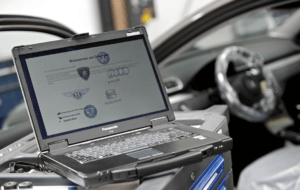
While on our summer vacation this year with our Volkswagen Van (“Bulli”), the engine warning light came on. Unfortunately, it was still over 700 km to our destination in the south of France. Everyone has experienced something like this, and everyone has the same questions: What does this mean now? Do we have to stop? Where can we find a Volkswagen garage in France, or might we even make it to our destination? Or, do we even have to stop immediately?
And furthermore, what does an engine warning light have to do with IT and monitoring?
How an engine warning light relates to IT and monitoring

If you think about it, we encounter situations just like this in IT as well. Usually when a “warning light” goes on somewhere in an organization, this information is immediately sent to the IT staff responsible for resolving the issue, at which time very similar questions arise as the ones asked on our vacation: What does this mean? Has something completely failed? What effect does this error message now have for the company, our employees and customers?
As with a car, troubleshooting now begins. In modern vehicles, fault diagnosis can almost only be done by the manufacturer or an authorized partner. What is always the same, however, is that a specialist must now evaluate this error message, request further information and data, and then diagnose it either using their expertise or a knowledge base. If a diagnosis is not possible, further specialists or the manufacturer must analyze the problem. Once the diagnosis is ensured, then work can be done to resolve the problem.
How can diagnosis time be reduced?
When an IT failure has an impact on the productivity of employees, or even on customers, a diagnosis must be made as quickly as possible so that a solution can be implemented right away. This is called reducing MTTR (Mean-Time-To-Repair). But how can this be achieved?
Usually, the most difficult challenge in the entire process is making a quick and correct diagnosis. This requires expertise, knowledge of one’s own environment, a structured approach and a lot of experience. Only experienced and specialized employees can use targeted questions to gather all the information needed for a rapid search for the cause—and this is where Riverbed IQ comes into play.
Riverbed IQ, Riverbed’s cloud-native, SaaS-delivered unified observability solution, automatically analyzes problems before any IT staff receive a report. In this process, the “expertise” of the staff is transferred into Riverbed IQ via a low-code UI. The result is a dashboard/report that contains all the necessary information about a problem, so IT engineers can diagnose it faster, without having to do extensive research.
Get results faster with fewer clicks
Riverbed IQ enables IT departments to work very much in the same way as authorized car repair garages. Car manufacturers have transferred their expertise to the diagnostic systems so that the engineers receive a pre-analyzed evaluation of a fault or issue in order to quickly start repairing the vehicle. In some cases, car manufacturers also refer directly to a “knowledge base article” on how to resolve the problem.
While Riverbed IQ isn’t quite there yet, Riverbed is already working on the next stage to have problems resolved automatically. Until then, Riverbed IQ has one goal: to keep IT staff from “digging” through a large amount of dashboards and data for a solution. In order to save time and resolve issues faster, IT will pre-analyze problems, much like garages do.
Watch the video below to see how Riverbed IQ reduces alert fatigue and Mean-Time-To-Repair:
If you like what you see and want to try it out for yourself, you can download a free trial here to experience it firsthand. Talk to us if you have any questions!
